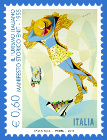DESTINATIONS
CONTACT US
CONTACTS
Travel the central Italy
"She had always been fond of history, and here [in Rome] was history in the stones of the street and the atoms of the sunshine."
Think of all that you love about Italy and you'll find it in these central regions of the country. Central Italy is known for its fine food, great wine, rolling hills, Cyprus trees, hilltop villages and wonderful architecture. It is also home to some of the most iconic landmarks in Italy such as the leaning tower of Pisa, the Coliseum, the Vatican and Uffizi Gallery. Travel through the itineraries and contact us by phone, email, or post with your ideas. One of our expert consultants will be at your disposal to take care of your travel logistics (hotel reservations, first class train tickets, airport transfers, restaurant reservations, and wine degustation), or someone seeking an in-depth travel experience by booking half day or full day tours with our expert local guides and drivers, our travel consultants will offer you a special and exclusive tour whenever and wherever you like to be.
Lazio, Abruzzo, Marche, Tuscany and Umbria
This area is possibly the most visited in Italy and contains many popular attractions. Rome boasts the remaining wonders of the Roman Empire. Florence, regarded as the birthplace of the Italian Renaissance, is Tuscany's most visited city, whereas nearby cities like Siena, Pisa, and Lucca also have rich cultural heritages. Umbria is smaller but it has many important cities such as Perugia and Assisi. The natural parks of Abruzzo include the Abruzzo National Park, the National Park of Gran Sasso and the National Park Maiella which every year attract thousands of visitors due to their nature and rare species of wildlife.
LAZIO
Beyond Rome, the region of Lazio inevitably pales in comparison, but there is plenty of things to do there, not least the landscape, which varies from the green hills and lakes of the northern reaches to the drier, more mountainous south. Primarily the ancient sites of Ostia Antica and the various attractions of Tivoli. Further afield, in northern Lazio, the Etruscan sites of Tarquinia provide the most obvious tourist focus, and the gentle beauty of lakes Bracciano, Vico and Bolsena. ROME is the most fascinating city in Italy, which makes it arguably the most fascinating city in the world. An ancient place packed with the relics of over two thousand years of inhabitation, you could spend a month here and still only scratch the surface. Yet it's so much more than an open-air museum: its culture, its food, its people make up a modern, vibrant city that would be worthy of a visit irrespective of its past. As a historic centre, it is special enough; as a contemporary European capital, it is unique.
ROME is the most fascinating city in Italy, which makes it arguably the most fascinating city in the world. An ancient place packed with the relics of over two thousand years of inhabitation, you could spend a month here and still only scratch the surface. Yet it's so much more than an open-air museum: its culture, its food, its people make up a modern, vibrant city that would be worthy of a visit irrespective of its past. As a historic centre, it is special enough; as a contemporary European capital, it is unique.
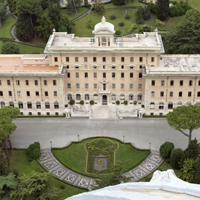 VATICAN STATE with the most famous Basilica of St Peter's and the amazing Vatican Museums it was founded following the signing of the Lateran Pacts between the Holy See and Italy on February 11th 1929. Walk through the Vatican Gardens have been a place of quiet and meditation for the popes since 1279 when Nicholas III moved his residence back to the Vatican from the Lateran Palace and the Dome. It was designed by Michelangelo, who worked on the construction of the basilica beginning in 1547.
VATICAN STATE with the most famous Basilica of St Peter's and the amazing Vatican Museums it was founded following the signing of the Lateran Pacts between the Holy See and Italy on February 11th 1929. Walk through the Vatican Gardens have been a place of quiet and meditation for the popes since 1279 when Nicholas III moved his residence back to the Vatican from the Lateran Palace and the Dome. It was designed by Michelangelo, who worked on the construction of the basilica beginning in 1547.
THINGS TO DO
There are some places that it would be a pity to leave the city without seeing. The churches, fountains and works of art from the period that can be said to most define Rome, the Baroque, and in particular the works of Borromini and Bernini. Fountain of the Four Rivers in the city's most famous square, Piazza Navona, among other things; but arguably his best sculptural work is in the Galleria Borghese. Other great palaces are themselves treasure-troves of great art, like the Doria Pamphilj and Palazzo Barberini; and there are some unmissable museums, like the Galleries of the Capitoline. And finally there's the city itself: stroll through the centro storico in the early morning, through Trastevere at sunset, or gaze down at the roofs and domes from the Janiculum Hill on a clear day, and you'll quickly realize that there's no place in Italy like Rome.ABRUZZO
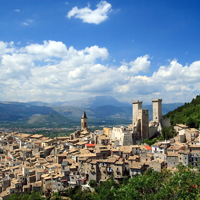
Bordered by the Apennines, Abruzzo holds some of Italy's wildest terrain: silent valleys, abandoned hill-villages and vast untamed mountain plains, once roamed by wolves, bears and chamois. The rising stars of Abruzzo are the hill-villages around L'Aquila, deeply rural places, where time seems to have stopped somewhere in the fifteenth century, whose traditions, cuisine and architecture are only now coming to be appreciated.
MOLISE
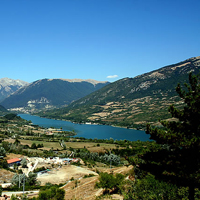
It has more in common with southern than central Italy. The cities, Isernia and Campobasso, are large and bland, with small historical centers, but Molise has its compensations: a scattering of low-key Roman ruins.
Visitors are starting to explore the area's ancient sheep-droving routes, which are gaining new life as mountain-bike or horseback-riding trails.
LE MARCHE
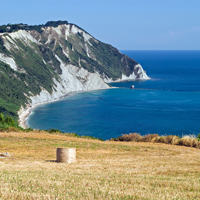 It is a varied region, and you could enjoy weeks of slow travel exploring. Sparsely populated inland areas are unspoilt and untouristed, particularly in the southwest, where stone hill-villages make atmospheric bases for hikes into the spectacular Monti Sibillini range. Ancona, the region's capital, is a port town which gives way heading southwards to the dramatic Conero Riviera, with its natural white-pebble beaches backed by milky Dover-esque cliffs. In contrast north and south of the Ancona area the coastline is hemmed with boxy new-build resorts.
It is a varied region, and you could enjoy weeks of slow travel exploring. Sparsely populated inland areas are unspoilt and untouristed, particularly in the southwest, where stone hill-villages make atmospheric bases for hikes into the spectacular Monti Sibillini range. Ancona, the region's capital, is a port town which gives way heading southwards to the dramatic Conero Riviera, with its natural white-pebble beaches backed by milky Dover-esque cliffs. In contrast north and south of the Ancona area the coastline is hemmed with boxy new-build resorts.
TUSCANY
The tourist brochures view of Tuscany as an idyll of olive groves, vineyards, hill-towns, but Tuscany is indeed the essence of Italy in many ways. Florence was the most active centre of the Renaissance, flourishing principally through the all-powerful patronage of the Medici dynasty. Every eminent artistic figure from Giotto, Masaccio, Brunelleschi, Donatello, Botticelli, Leonardo da Vinci, Michelangelo - is represented here, in an unrivalled gathering of churches, galleries and museums. The problem is, of course, that the whole world knows about the attractions of Florence, with the result that the city can be so busy in high season.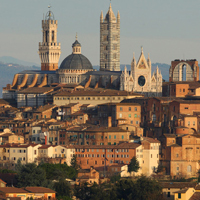
SIENA One of the great medieval cities of Europe, it remains almost perfectly preserved, and holds superb works of art in its religious and secular buildings. In addition, its beautiful Campo - the central, scallop-shaped market square - is the scene of the Palio, when bareback horseriders career around the cobbles amid an extravagant display of pageantry.
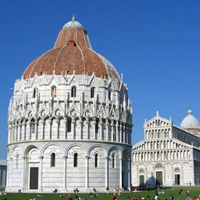
PISA and LUCCA have their own fair share of attractions and provide convenient entry points to the region, either by air (via Pisa's airport) or along the coastal rail route from Genoa. Arezzo and Cortona serve as fine introductions to Tuscany if you're approaching from the south (Rome) or east (Perugia).
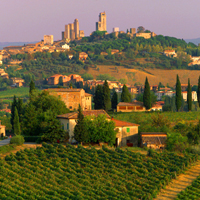 A dozens of small hill-towns such as San Gimignano, the most famous, is worth visiting as much for its spectacular frescoes as for its bristle of medieval tower-houses. Both Montepulciano and Pienza are superbly located and dripping with atmosphere, but the best candidates for a Tuscan hill-town escape are places such as Volterra or Pitigliano, where tourism has yet to undermine local character. You may find lesser-known sights even more memorable - remote monasteries like Monte Oliveto Maggiore and San Galgano, or the sulphur spa of Bagno Vignoni.
A dozens of small hill-towns such as San Gimignano, the most famous, is worth visiting as much for its spectacular frescoes as for its bristle of medieval tower-houses. Both Montepulciano and Pienza are superbly located and dripping with atmosphere, but the best candidates for a Tuscan hill-town escape are places such as Volterra or Pitigliano, where tourism has yet to undermine local character. You may find lesser-known sights even more memorable - remote monasteries like Monte Oliveto Maggiore and San Galgano, or the sulphur spa of Bagno Vignoni.
UMBRIA
The green heart of Italy, Umbria is a predominantly beautiful and largely unspoiled region of rolling hills, woods, streams and valleys. Within its borders it also contains a dozen or so classic hill-towns, each resolutely individual with artistic and architectural treasures to rival bigger and more famous cities..
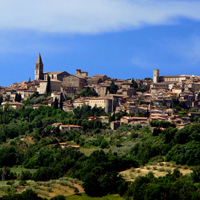 Perugia, Assisi with their extraordinary frescoes by Giotto in the Basilica di San Francesco - or Orvieto, whose Duomo is one of the greatest Gothic buildings in the country. For a taste of the region's more understated qualities, it's best to concentrate on lesser-known places such as Todi, Gubbio, ranked as the most perfect medieval centre in Italy, and Spoleto, for many people the outstanding Umbrian town. Lago Trasimeno, which is the largest lake in the Italian peninsula, with plenty of opportunities for swimming and watersports.
Perugia, Assisi with their extraordinary frescoes by Giotto in the Basilica di San Francesco - or Orvieto, whose Duomo is one of the greatest Gothic buildings in the country. For a taste of the region's more understated qualities, it's best to concentrate on lesser-known places such as Todi, Gubbio, ranked as the most perfect medieval centre in Italy, and Spoleto, for many people the outstanding Umbrian town. Lago Trasimeno, which is the largest lake in the Italian peninsula, with plenty of opportunities for swimming and watersports.


